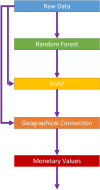Mental health and natural land cover: a global analysis based on random forest with geographical consideration
- PMID: 38316893
- PMCID: PMC10844245
- DOI: 10.1038/s41598-024-53279-7
Mental health and natural land cover: a global analysis based on random forest with geographical consideration
Abstract
Natural features in living environments can help to reduce stress and improve mental health. Different land types have disproportionate impacts on mental health. However, the relationships between mental health and land cover are inconclusive. In this study, we aim to accurately fit the relationships, estimate the impacts of land cover change on mental health, and demonstrate the global spatial variability of impacts. In the analysis, we show the complex relationships between mental health and eight land types based on the random forest method and Shapley additive explanations. The accuracy of our model is 67.59%, while the accuracy of the models used in previous studies is usually no more than 20%. According to the analysis results, we estimate the average effects of eight land types. Due to their scarcity in living environments, shrubland, wetland, and bare land have larger impacts on mental health. Cropland, forest, and water could improve mental health in high-population-density areas. The impacts of urban land and grassland are mainly negative. The current land cover composition influences people's attitudes toward a specific land type. Our research is the first study that analyzes data with geographical information by random forest and explains the results geographically. This paper provides a novel machine learning explanation method and insights to formulate better land-use policies to improve mental health.
© 2024. The Author(s).
Conflict of interest statement
The authors declare no competing interests.
Figures































Similar articles
-
GIS based mapping of land cover changes utilizing multi-temporal remotely sensed image data in Lake Hawassa Watershed, Ethiopia.Environ Monit Assess. 2014 Mar;186(3):1765-80. doi: 10.1007/s10661-013-3491-x. Epub 2013 Dec 6. Environ Monit Assess. 2014. PMID: 24310365
-
Mapping deforestation and urban expansion in Freetown, Sierra Leone, from pre- to post-war economic recovery.Environ Monit Assess. 2016 Aug;188(8):470. doi: 10.1007/s10661-016-5469-y. Epub 2016 Jul 14. Environ Monit Assess. 2016. PMID: 27418077
-
Modelling hydrological effects of wetland restoration: a differentiated view.Water Sci Technol. 2009;59(3):433-41. doi: 10.2166/wst.2009.884. Water Sci Technol. 2009. PMID: 19213997
-
Investigation of land cover (LC)/land use (LU) change affecting forest and seminatural ecosystems in Istanbul (Turkey) metropolitan area between 1990 and 2018.Environ Monit Assess. 2022 Dec 13;195(1):196. doi: 10.1007/s10661-022-10785-3. Environ Monit Assess. 2022. PMID: 36512115 Review.
-
Multiscale land use impacts on water quality: Assessment, planning, and future perspectives in Brazil.J Environ Manage. 2020 Sep 15;270:110879. doi: 10.1016/j.jenvman.2020.110879. Epub 2020 Jun 12. J Environ Manage. 2020. PMID: 32721318 Review.
Cited by
-
Clustering and classification for dry bean feature imbalanced data.Sci Rep. 2024 Dec 28;14(1):31058. doi: 10.1038/s41598-024-82253-6. Sci Rep. 2024. PMID: 39730714 Free PMC article.
-
Early detection of mental health disorders using machine learning models using behavioral and voice data analysis.Sci Rep. 2025 May 13;15(1):16518. doi: 10.1038/s41598-025-00386-8. Sci Rep. 2025. PMID: 40360580 Free PMC article.
References
-
- MacKerron G, Mourato S. Happiness is greater in natural environments. Glob. Environ. Chang. 2013;23:992–1000. doi: 10.1016/j.gloenvcha.2013.03.010. - DOI
-
- Malek Ž, Verburg PH. Mapping global patterns of land use decision-making. Glob. Environ. Chang. 2020;65:102170. doi: 10.1016/j.gloenvcha.2020.102170. - DOI
MeSH terms
Grants and funding
LinkOut - more resources
Full Text Sources
Medical

